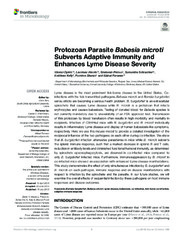Prikaz osnovnih podataka o dokumentu
Protozoan parasite babesia microti subverts adaptive immunity and enhances lyme disease severity
| dc.creator | Đokić, Vitomir | |
| dc.creator | Akoolo, L. | |
| dc.creator | Primus, S. | |
| dc.creator | Schlachter, S. | |
| dc.creator | Kelly, K. | |
| dc.creator | Bhanot, P. | |
| dc.creator | Parveen, N. | |
| dc.date.accessioned | 2021-04-20T13:01:57Z | |
| dc.date.available | 2021-04-20T13:01:57Z | |
| dc.date.issued | 2019 | |
| dc.identifier.issn | 1664-302X | |
| dc.identifier.uri | http://rimi.imi.bg.ac.rs/handle/123456789/927 | |
| dc.description.abstract | Lyme disease is the most prominent tick-borne disease in the United States. Co-infections with the tick-transmitted pathogens Babesia microti and Borrelia burgdorferi sensu stricto are becoming a serious health problem. B. burgdorferi is an extracellular spirochete that causes Lyme disease while B. microti is a protozoan that infects erythrocytes and causes babesiosis. Testing of donated blood for Babesia species is not currently mandatory due to unavailability of an FDA approved test. Transmission of this protozoan by blood transfusion often results in high morbidity and mortality in recipients. Infection of C3H/HeJ mice with B. burgdorferi and B. microti individually results in inflammatory Lyme disease and display of human babesiosis-like symptoms, respectively. Here we use this mouse model to provide a detailed investigation of the reciprocal influence of the two pathogens on each other during coinfection. We show that B. burgdorferi infection attenuates parasitemia in mice while B. microti subverts the splenic immune response, such that a marked decrease in splenic B and T cells, reduction in antibody levels and diminished functional humoral immunity, as determined by spirochete opsonophagocytosis, are observed in co-infected mice compared to only B. burgdorferi infected mice. Furthermore, immunosuppression by B. microti in coinfected mice showed an association with enhanced Lyme disease manifestations. This study demonstrates the effect of only simultaneous infection by B. burgdorferi and B. microti on each pathogen, immune response and on disease manifestations with respect to infection by the spirochete and the parasite. In our future studies, we will examine the overall effects of sequential infection by these pathogens on host immune responses and disease outcomes. Copyright © 2019 Djokic, Akoolo, Primus, Schlachter, Kelly, Bhanot and Parveen. This is an open-access article distributed under the terms of the Creative Commons Attribution License (CC BY). The use, distribution or reproduction in other forums is permitted, provided the original author(s) and the copyright owner(s) are credited and that the original publication in this journal is cited, in accordance with accepted academic practice. No use, distribution or reproduction is permitted which does not comply with these terms. | en |
| dc.rights | openAccess | |
| dc.rights.uri | https://creativecommons.org/licenses/by/4.0/ | |
| dc.source | Frontiers in Microbiology | |
| dc.subject | Adaptive immune response | en |
| dc.subject | Babesia microti | en |
| dc.subject | Babesiosis | en |
| dc.subject | Borrelia burgdorferi | en |
| dc.subject | Co-infection | en |
| dc.subject | Lyme disease | en |
| dc.subject | Tick-borne co-infection | en |
| dc.title | Protozoan parasite babesia microti subverts adaptive immunity and enhances lyme disease severity | en |
| dc.type | article | |
| dc.rights.license | BY | |
| dc.citation.issue | JULY | |
| dc.citation.other | 10(JULY): - | |
| dc.citation.rank | M21 | |
| dc.citation.volume | 10 | |
| dc.identifier.doi | 10.3389/fmicb.2019.01596 | |
| dc.identifier.fulltext | http://rimi.imi.bg.ac.rs/bitstream/id/724/924.pdf | |
| dc.identifier.scopus | 2-s2.0-85069501642 | |
| dc.type.version | publishedVersion |

